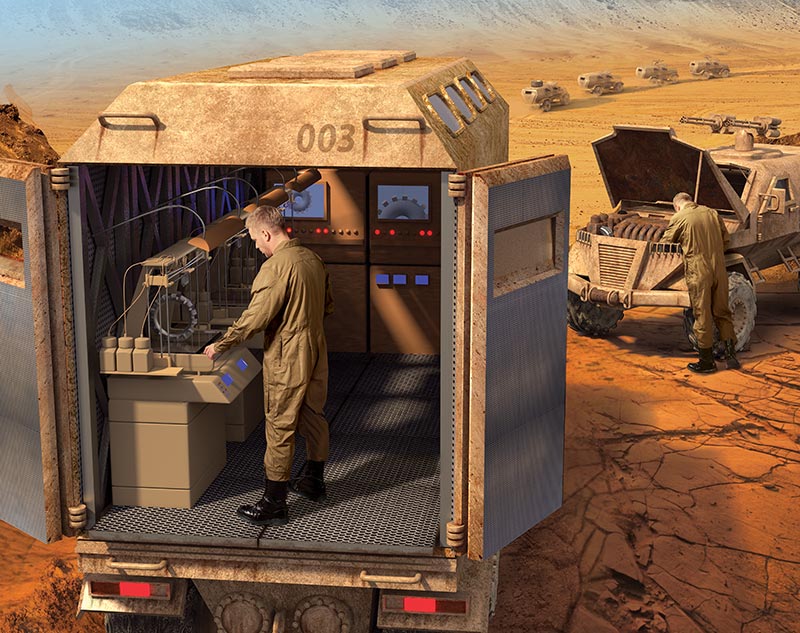Clemson University has established an $11 million cooperative agreement with the US Combat Capabilities Development Command of the Army Research Laboratory, known as DEVCOM ARL, to create new technologies that will speed up the development of new 3D printed components for the US military’s ground vehicles, air platforms, and munitions.
Throughout the project, Clemson University will leverage the direct metal printing, advanced plastics, and composites technology of 3D printer manufacturer 3D Systems.
The project will involve the creation of an Artificial Intelligence (AI) powered “digital lifecycle platform” to enable the army’s engineers to design and test new components without physically building them, and the formation of a raw materials database for new potential 3D printing feedstock materials.
“This agreement is another example of Clemson’s growing emphasis on partnering with industry and the government to leverage the university’s research expertise to benefit our state and nation,” said Jim Clements, Clemson President.
“I am very proud of the work being done by our faculty that will allow this cutting edge technology to play an important role in the creation of next-generation vehicles and other vital equipment for our military.”

Creating a digital lifecycle platform
One of the main aims of the project is to create a digital lifecycle platform that uses AI to help production engineers design, analyze, and build components more quickly at lower costs.
Once produced, the platform will enable users to develop a wide variety of large components with complex geometries and embedded multi-functionalities. These kinds of components could include vehicle parts with power transmissions, energy storage, sensing and self-monitoring functions, and the platform would help to optimize their overall size, weight, power, and cost (SWaP-C) efficiencies.
The ultimate aim of the platform is to enable engineers to design and test new components without physically building them.

The first phase of the project will see $6.3 million funding be made available to support the ongoing research at the Clemson Composites Center, located in the Greenville Technical College’s Center for Manufacturing Innovation. Here, the Clemson researchers will leverage the technology and capabilities of the “world’s largest metal 3D printer” 3D Systems is creating for DEVCOM ARL.
The printing system, which is equipped with nine lasers and a large-format build chamber measuring 1m x 1m x 600mm will be used to address the ammunition, ground vehicle, helicopter, and missile defense needs of the Armed Forces.
3D Systems was recently chosen by DEVCOM ARL to take part in a separate research project that aims to develop 3D printed topologically optimized heat exchangers for the US Army using its DMP Factory 500 3D printer.
“3D Systems was founded on a spirit of innovation, and our customers’ unique applications fuel our efforts to create new technologies,” said Jose Doval, Advanced R&D Director at 3D Systems. “Through our collaboration with the US Army Research Laboratory, we’ve made tremendous strides in developing the world’s largest, fastest metal powder 3D printer. Expanding this work with Clemson University allows us to push the limits of the technology even further.
“This includes investigating new methods of in-situ detection, as well as ways to visualize the build in real-time from the data collected in each layer.”
Developing a raw material database
The Clemson researchers will also seek to establish a database of raw materials consisting of metals, plastics, and composite materials, to aid research into the properties of 3D printing feedstock.
The researchers will print samples of the raw materials and carry out a series of tests to measure their chemical, mechanical, and thermophysical properties in order to create digital models of potential new feedstock materials. In the future, subcomponents will be 3D printed that take into account the complex geometries of full-size components and the observed properties of the database materials.
“The database development as well as validation of the digital life cycle through experimental characterization and testing are enabled using the state-of-the-art infrastructure available at the Clemson Composites Center which includes 3D printers, thermophysical testing equipment, optical metrology, quasi-static and dynamic drop-tower test infrastructure, accelerated aging equipment, high-speed cameras and spectroscopic equipment,” said Srikanth Pilla, Professor within the College of Engineering, Computing and Applied Sciences and founding director of the Clemson Composites Center.

Collaborating on the MX Initiative
Clemson University is also collaborating with the ARL on another project known as the MX Initiative, which brings together a multidisciplinary team of faculty members to carry out fundamental and applied research to support the modernization and future capabilities of the US Army.
According to DEVCOM ARL, the collaboration with Clemson will help it to find new ways to advance the science of additive manufacturing while helping to create a pipeline of new talent within the sector. The collaboration will also aid in further expanding the applications of 3D Systems’ metal 3D printing technologies.
“Over the past few years South Carolina has seen record investment and growth, a large portion of which can be accredited to the willingness of our colleges and universities to partner with new and existing businesses,” said Governor Henry McMaster.
“This project between Clemson and 3D Systems highlights the success and the continued commitment of our higher education system to not only provide a highly skilled workforce but to forge important partnerships with our business community that ultimately lead to a stronger South Carolina.”
Subscribe to the 3D Printing Industry newsletter for the latest news in additive manufacturing. You can also stay connected by following us on Twitter and liking us on Facebook.
Looking for a career in additive manufacturing? Visit 3D Printing Jobs for a selection of roles in the industry.
Featured image shows Clemson University project leaders Srikanth Pilla, Fadi Abdeljawad and Gang Li (left to right) as well as Shunyu Liu and Rahul Rai (not pictured) will drive research from the Clemson Composites Center in Greenville. Photo via Clemson University.


